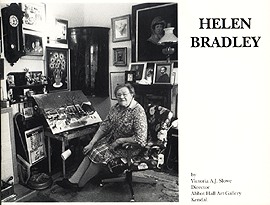Abbot Hall Art Gallery Catalogue 1989.
HELN BRADLEY by Victoria Slowe © 1989.

It is perhaps a truism to define the essential "Englishness" of English art as the detailed study, in depth, of a particular place or area. The genius loci has enthralled artists as varied as John Constable at Dedham, Samuel Palmer at Shoreham, Stanley Spencer at Cookham - and Helen Bradley at Lees, on the outskirts of Oldham - and has inspired very different responses. Such close study always invests the artist's work with a special magic.
I first got to know the late Helen Bradley and her unique approach to painting when her work was exhibited here at Abbot Hall Art Gallery, Kendal, in March 1970.
That exhibition made a tremendous impression on me because of the way in which Helen Bradley transmitted her childhood memories of the everyday - and Sunday best - life of ordinary Lancashire mill folk into anecdotal art. The paintings embodied a visual version of the "oral history" then just coming into vogue.
For, of course, Helen Bradley was a notable raconteur - in paint and prose. She was doubly gifted, as Miss Carter Wore Pink and the succeeding books made clear.
The paintings have a curiously cinematic effect - edited events, freeze framed, staged in such a manner that the story line is obvious, playing the emotions, but somehow maintaining directness and objectivity. The vision is amplified by the frank and uninhibited prose, leavened by a sardonic humour, which points to a rare appreciation of humanity. Helen Bradley enjoys devastating simplicity, basic commonsense and high fantasy to an equal degree, which encompasses a meeting with Adam and Eve on the sandhills of Blackpool, an escape from The Flood in Lees on an upturned kitchen table, the Gathering of Ivy for Christmas Garlands, the despised Willie Murgatroyd threatening to thump the Punch and Judy Man, and the elegant Miss Carter (who wore pink), with equal felicity.
Castigated at the start of her career as a "primitive" or "naive" painter - perhaps two of the most pejorative descriptive terms for painters in the critics' vocabulary - Helen Bradley was unperturbed and continued, unruffled, on her own original path. She knew - as the drawings and sketchbooks on display in this exhibition illustrate so admirably - that she could compose to an academic formula. But she also knew that her vision of the past demanded a different approach. She was not a sophisticated adult contriving to paint her childhood memories: She was that child, candidly and spontaneously reporting and recording events, as she re-lived them, as they happened. The innocence, the happiness, the sunny joy of childhood, shine through, honour bright.
The pictorial treatment is influenced by Persian and Moghul miniatures, (flat, rich, decorative patterns with no roundness and no shadows), by Dutch Old Masters, (genre scenes of close-knit communities, reeking atmosphere, painstaking detail), and by Chinese painting, (almost palpable air and vapour). The technique is suited to the subject matter: skies and distances are swept in broadly with the palm of the hand, enjoying the sensuous quality of the oil paint, whilst the pattern of tree branches, brick work or setts is scraped out with the sharp end of the brush to give structure and articulation.
Helen Bradley's canvasses are an open book: she tells anecdotes in paint and she paints with words.
During the fourteen years which stretched from 1965, when she began to paint, (nearly fifty years after her attendance at the Oldham School of Art, where her main interests were embroidery and jewelry), until her death in 1979, (just a week before she was due to receive the MBE from Her Majesty the Queen at Buckingham Palace), Helen Bradley created many much-loved images which are known to the multitude via her books and limited edition prints and to a small number of collectors from the originals they possess. In the year before she died, she painted six pictures depicting the days of the week and put them away in the back, and these will be on view to the public for the first time.
I hope that those who view this major retrospective exhibition at Abbott Hall from 22 July until 3 September 1989 will spare a thought for those whose walls are temporarily bare in order to give our visitors - you - the rare opportunity of seeing Helen Bradley's original paintings.
I should like to record my thanks to all the lenders, (some of whom are publicly acknowledged but the majority of whom wish to remain anonymous), and to the co-organizers of the exhibition, Mr. Keith Lee of Miss Carter Publications, and Mr. William H. Patterson of W. H. Pattersons Fine Arts Limited, 19 Albemarle Street, London, W.1., who have co-ordinated the loans. The late Helen Bradley's family has been extremely generous in lending material hitherto unexhibited and I should like to express my thanks to all of them for their support and ready co-operation.
The retrospective exhibition may be being held later rather than sooner, but it is intended as a sincere and loving tribute to a true Lancashire lass. As L.S. Lowry remarked, "Helen Bradley is unique". I hope you will savour her remarkable talent to the full.
Victoria A. J. Slowe Director Abbot Hall Art Gallery Kendal